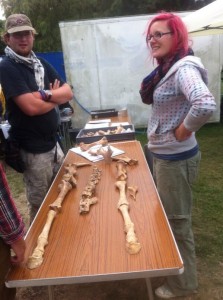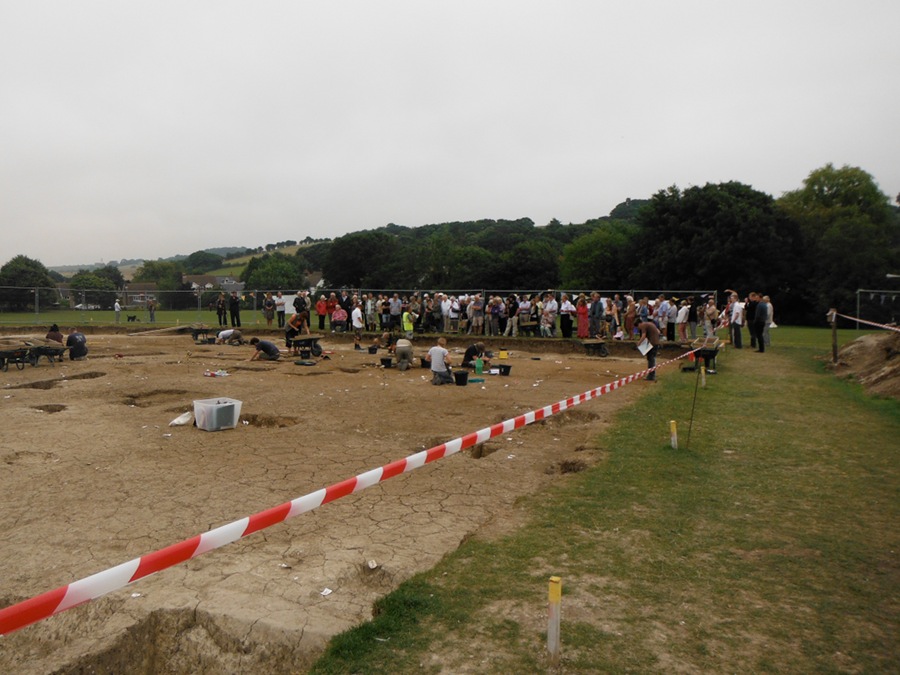What an amazing few days we’ve had here in Lyminge! We’ve been incredibly busy so this time I have turned two blog posts into one to get you caught up on the whirlwind of activity that has been the Lyminge dig over last week or so!
We were thrilled to have an amazing turn out for our open day on Saturday, even though the weather was a little changeable.
We’re incredibly grateful to Bethany, our visitor liaison, who ran such a fantastically smooth and stress free day. We got around 500 visitors over the course of the day, 200 more than last year’s event! It seems word has got around and we’re thrilled to be able to share our findings with such a large number of people. Don’t forget we are still running Saturday site tours at 2pm until the end of the dig. The last will be on the 31st August.
We were visited by Centingas, a local group of Saxon re-enactors who helped to bring to life the people who lived in the settlement we are excavating at Lyminge during the 5th-7th centuries AD. Here Emily (Aelfwynn), who is also our assistant Finds Supervisor, learns to weave with Deorwynn (left).
A huge amount of help from villagers, volunteers, students and staff made for a fantastic day, and we heard so many saying they had enjoyed themselves which makes it all worth it. The site tours were extremely well attended, even with Gabor having to battle against the noise of the wind and church bells!
The children had lots to do too, with a chance to try out digging themselves on the ‘little dig’, and lots of worksheets and colouring to do – our university students helped our smaller visitors design a Saxon brooch.
One of our popular attractions was the Saxo-Norman horse! Our zooarchaeology expert Zoe Knapp was on hand to answer questions about animal bones, and with

Zoe shows our visitors what a horse’s skeleton looks like. This horse was found in a Saxo-Norman ditch and dates to around the 12th Century
the help of recent archaeology graduate Cordelia Laycock, fielded all of these and many more regarding the animal bone at Lyminge and what people were eating and farming.
Our finds tables were well attended too! Helen and her team of volunteers, (both local and part of our student contingent) manned the desks and showed everyone the fascinating things we have found so far – and not just Anglo-Saxon finds that I have been showing you in the blog, but lots from the World War II structures and the Late Medieval period too. Some of these were identified by members of the public too!

Manning the finds desk on the open day – we had some great suggestions as to what some of our metalwork might be. The large piece in the foreground is a WWII frying pan from the cook house!
Simon and his Environmental team helped to explain the sampling strategies we employ on site to search for charred grains, charcoal and other archaeobotanical remains, as well as things like snails and fish bone.

Luke, Alex, Simon and Pip sorting residues for snails, seeds and small animal bones – Alex seems to be enjoying himself!
Geoff Halliwell returned this year to show us how flint was knapped into tools in the past – despite our Anglo-Saxon site we do actually have an extremely large assemblage of mesolithic tools and other worked and struck flints in Lyminge, which show us that we have occupation in the area for more than 10,000 years.
But what of the digging?! Excavation continued all day on the open day, albeit with a slightly reduced team.
Significant progress has been made since the last blog post. The timber buildings are now under intensive excavation and structural details are being revealed.

Aerial shot of the doorway area in the larger timber hall captured by Steve Thomas using a camera on a very long telescopic arm
Slots have been placed over various significant areas in the timber halls. We are now certain, as many of you will have heard on the open day tours, that the less elaborate hall

Aiji excavates a slot over a raking post and a wall trench in the eastern long wall of the later timber hall
with narrower wall trenches is earlier in date than the hall that has the elaborate entrances and extremely deep rectangular post pits. The later hall is a replacement for something slightly less ‘fancy’.
The later hall had timber raking posts that were put in slightly after the wall trenches were dug. These would be for extra support for the roof and show we have a different method of construction to the the hall we excavated last year which didn’t have any evidence for raking posts at all. The door pit on the western side of the later timber hall is now fully bottomed, and you can see from the photograph below that it is a considerable depth.
Thus far we only have evidence for one timber, which you can see in the section (if you look very carefully!) as the narrow dark line with a piece of Roman tile right underneath it at the bottom. We need to complete excavation of this rectangular pit (more than 2m long!) before we can say what kind of doorway or entrance construction there might have been. What we can suggest is that, considering that we have lost the original ground surface due to erosion, the original height of the door posts above ground might have been as much as four metres! Could this building have been of two storeys? Further excavation will add to the picture.
The photos above show some of the wall trenches of the two timber buildings under excavation, but you can see in these photographs that the timber ‘ghosts’ of the posts that were once in place in the wall trenches survive remarkably well.
Rachel is excavating the ghosts in the north end wall trench of the earlier timber building, and you can see how clearly the construction methods come up in the subsequent photo below. This part of the wall trench cuts right across SFB 6, so we can tell that the
building is later than this sunken-featured building. Unlike last year’s ‘Great Hall’, the wall trenches here only have a single line of planks. The Great Hall had paired planks all the way along its walls, which goes along with the fact that it was a much larger building.
The buildings themselves are particularly fascinating as we now have several different types of construction, as well as some phasing on site for the first time – we can track the development of the settlement from SFBs to relatively simple timber buildings, through to more elaborate constructions such as the Great Hall and this year’s 15m x 8m timber hall that may have had more than one storey.
The story doesn’t end with the structures, however. A recent find gives us an insight into the type of community living in Lyminge, as if amethyst beads, brooches and horse harness mounts aren’t enough! Just a few days ago this rather unusual animal bone turned up in SFB 7. We all scratched our heads, as none of us recognised it and Zoe was particularly keen to get to the bottom of it!
After a bit of research we discovered that we had a scute from a sturgeon, an enormous fish that is today endangered and famous for being the source of caviar. The ‘scute’ is part of the sturgeons bony protection, a little bit like armour plating, as it doesn’t have scales.
Sturgeon have been known to grow as large as 5 metres long, but more commonly reach around 2m-3m, depending on the species. They are coastal and riverine bottom feeders. Sturgeon were highly prized in the late Saxon period and even now are part of the group known as ‘Royal Fish’ along with whales and porpoises, establishing that these fish are the property of the monarch when found or fished in the United Kingdom. Sturgeons in early Anglo-Saxon contexts are extremely rare, and this evidence suggests a settlement of great wealth and status at Lyminge in the pagan period – which entirely matches the archaeological evidence we have so far!
Finally, if you have been following the blog this season you will remember that I introduced you all to the very interesting pit full of large flint nodules and iron smelting evidence in the north east corner of our trench. This pit has been under excavation for some days now, and Alex had considered that he was nearly done!
We had always been intrigued by a dark clay ring around the edge of the pit. It turns out that what we had thought was the natural chalk bedrock was in fact a capping layer of chalk dumped in to the pit.

A section through the pit full of smelting slag – a chalk capping layer covers layers of clay and highly organic material. The sunshine makes photography at depth difficult! The ranging pole is 1m long.
Underneath this chalk was a very thick layer of clay and then an incredibly organic deposit that is full of animal bone and other organic waste. At the very bottom the articulated skeleton of a piglet was discovered, part of which you can see here. Further rib bones and other parts have been found since this photo was taken.

The bones of a piglet which would have been whole when it went in the ground come out of the very bottom of a large early Saxon pit that was full of iron smelting slag and flint nodules.
This sort of deposition is something we’re going to examine closely – it seems that the piglet has not been butchered and it is curious for a whole suckling pig to be disposed of in this manner. The association with smelting evidence gives us cause to think of ethnographic examples of rituals surrounding the smelting of iron, although it is very early to be thinking along these lines! The rarity of early Saxon pits is also an interesting issue to consider here.
I do hope you have been able to keep going through this mammoth post! We have just over a week of digging to go and a huge amount to do, so I will do my best to keep you all updated on Facebook and twitter as well as the blog with all finds and features as they are uncovered. Watch this space!
















